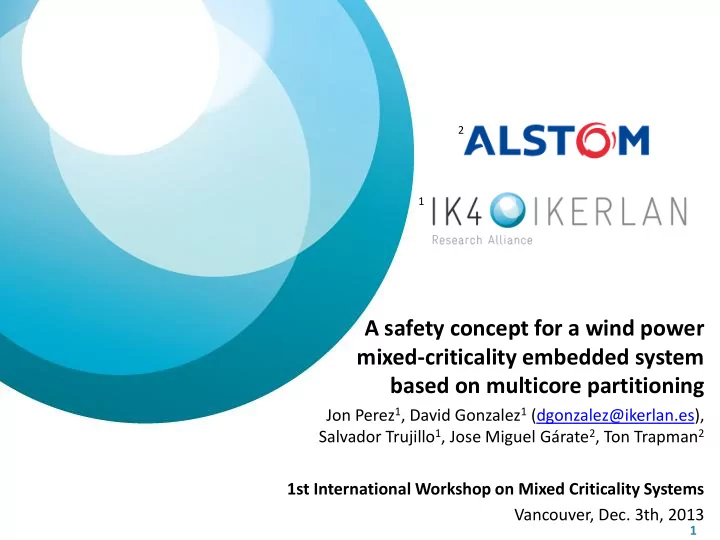

2 1 A safety concept for a wind power mixed-criticality embedded system based on multicore partitioning Jon Perez 1 , David Gonzalez 1 (dgonzalez@ikerlan.es), Salvador Trujillo 1 , Jose Miguel Gárate 2 , Ton Trapman 2 1st International Workshop on Mixed Criticality Systems Vancouver, Dec. 3th, 2013 1
Contribution of the paper This paper presents a safety certification strategy for IEC- 61508 compliant industrial mixed-criticality systems based on multicore and virtualization . The safety concept of a wind power case-study is currently under review by a certification body . 2
Definitions and problem statement Criticality level of an application is a classification of how severe a deviation of the intended behavior is. Criticality level of a system is defined as the highest criticality of the jobs executed within it. Today’s embedded systems typically integrate functionalities with different criticality levels. Without appropriate preconditions, the integration of mixed-criticality subsystems can lead to a significant and potentially unacceptable increase of certification efforts. 3
Towards mixed-criticality systems Federated architectures have limitations: – Complexity. – Scalability. – Number of subsystems, connectors and wires impacts on overall reliability . – Cost-size-weight . Mixed-criticality systems overcome these limitations. Safety certification according to industrial standards becomes a challenge. 4
IEC-61508 and derived standards IEC-61508 is an international standard for electrical, electronic and programmable electronic safety related systems . IEC-61508 is a generic safety standard from which different domain specific standards have been derived for industrial and transportation domains. It defines Safety Integrity Level (SIL) 1 .. 4 It is intended for fail-safe systems. – Fail-safe: there is a safe-state – Fail-operational: there is no safe-sate 5
Multicore and virtualization Multicore and virtualization technology can support the development of mixed-criticality systems. Partitions provide functional separation of the applications and fault containment. The challenge is to provide sufficient evidence of isolation , separation and independence among safety and non-safety related functions. IEC-61508 safety standard does not directly support nor restrict the certification of mixed-criticality systems, but: – Sufficient independence must be shown. – Otherwise, all integrated functions will need to meet the highest integrity level. 6
Temporal and spatial isolation Sufficient independence implies temporal and spatial isolation : – The temporal isolation is achieved if the duration of every single action performed by applications in one partition is independent from actions performed by all other partitions. – Spatial isolation (inter partition) must prevent all partitions from accessing memory or interfaces that are not in their a-priori known scope. If temporal and spatial isolation is achieved, subsystems with different levels of criticality can be placed in different partitions and can be verified and validated in isolation. 7
Safety certification strategy IEC-61508 and fail-safe systems: – Diagnosis techniques must be used to detect temporal isolation violations. – Thus, the lack of complete temporal isolation does not compromise safety, but availability. Hypervisor and platform as a compliant item: – Startup, configuration and initialization – Virtualization of resources – Isolation, diagnosis and integrity – Communication and synchronization Static cyclic scheduling of partitions with guaranteed timeslots defined at design time. Diagnosis strategy 8
Wind power case study Wind turbine supervision and control system provides three major functionalities : – Supervision : wind turbine real-time control and supervision. – Communications and HMI : non real-time Human Machine Interface (HMI) and communication with SCADA system. – Protection : safety functions to ensure that the design limits of the wind turbine are not exceeded (e.g. overspeed, ISO-13849 PLd). These functionalities are currently deployed in different platforms. 9
Safety Concept in two steps Two transformations – From a federated architecture to multiprocessor – From multiprocessor to multicore 10
Safety Concept: Multiprocessor 1oo2 architecture HFT = 1 2 independent processors 2 shared diverse input sources (rotation speed) 2 output relays Safety-relays can be de- activated (safe-state) either directly by ’safety protection’ or indirectly by ’diagnosis’. Limitation: scalability 11
Safety Concept: Multicore with virtualization ‘Partitions’ mapped to a multicore processor Heterogeneous quad core Dual diverse cores for safety partitions Resource usage and performance maximization Requirement: IEC-61508-2 Annex E for on-chip redundancy 12
Conclusions and future work Safety certification of mixed-criticality systems based on COTS multicore processors is challenging, but feasible . This paper presents a safety-certification strategy for IEC-61508 compliant safety systems based on COTS multicore processors. The safety concept of a wind power case-study is currently under detailed review by a certification body. The assumptions and analysis considered at this stage will be reviewed in the following design stages and validated at the final stage of the case- study within FP7 MultiPARTES project. 13
Eskerrik asko Muchas gracias Thank you Merci beaucoup P.º J.M. Arizmendiarrieta, 2 20500 Arrasate-Mondragón (Gipuzkoa) Tel.: 943 71 24 00 Fax: 943 79 69 44 www.ikerlan.es 14
Recommend
More recommend